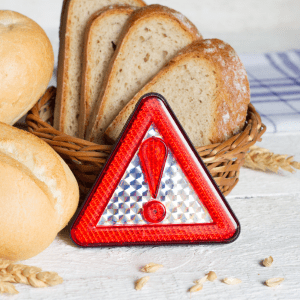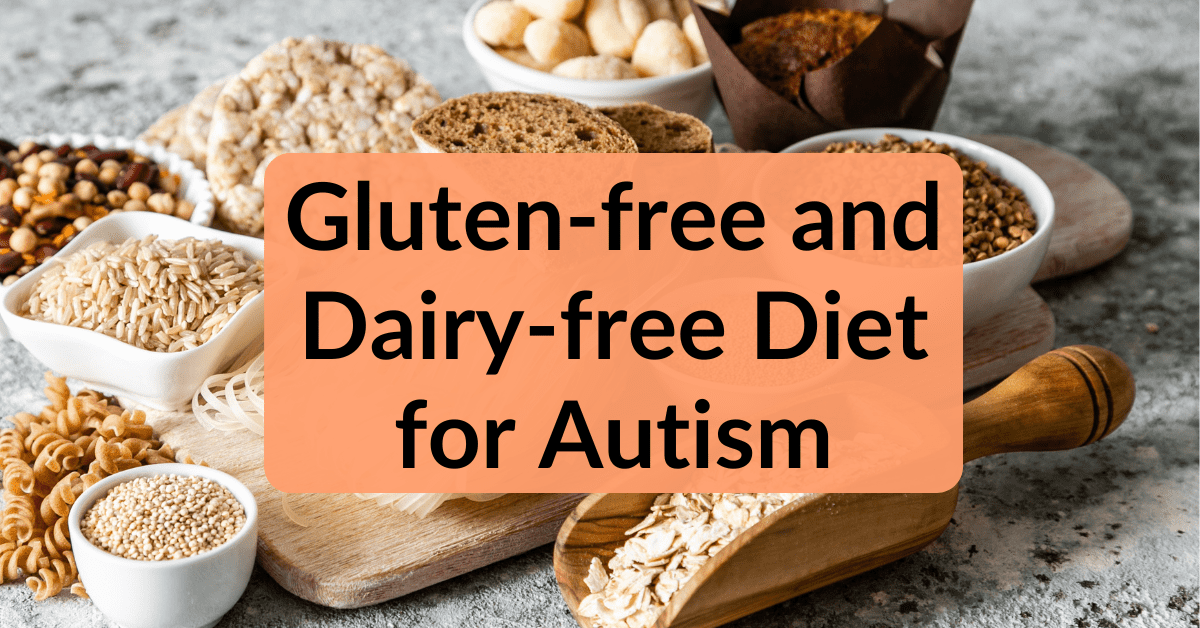Last updated on March 17th, 2025 at 08:57 am
Are you a parent of a child on the spectrum looking to discover how gluten-free diet for autism can help manage behaviors?
If you are looking for a more nutritional approach and have been introduced to the gluten free and dairy free (GFCF) diet, you are probably wondering if it is actually effective for managing autism symptoms.
The research shows that a diet focusing on the removal of gluten and dairy for people with autism can result in improved language skills, behavior, and social functioning in some individuals.
A gluten-free and dairy-free diet is not a “one size fits all” approach to treating autism, but it can be helpful in many cases.
It’s important to understand the basics of this kind of diet before making any changes.
In this blog post, we’ll take a look at some of the evidence linking gluten-free and dairy free diet with better outcomes for people with autism, as well as tips on implementing such an approach successfully.
Read on to learn more about how going GFCF diet can help make life easier – and perhaps more enjoyable! – for those living with autism.
Disclosure: There are affiliate links in this post. If you click the link and buy something, I might get a commission at no additional cost to you!
What is Gluten?
 Gluten is a protein found in wheat, rye, and barley. It’s usually present in several processed foods, such as bread, pasta, and some breakfast cereals.
Gluten is a protein found in wheat, rye, and barley. It’s usually present in several processed foods, such as bread, pasta, and some breakfast cereals.
Gluten can also be hidden in unexpected places like soy sauce and candy bars.
For people with celiac disease or gluten sensitivity, eating even small amounts of this protein can cause negative symptoms ranging from digestive issues to skin problems.
When it comes to autism, the protein found in gluten, gliadin, has been found to have a negative effect on the symptoms of autism.
It is believed that the protein found in gluten acts similarly to opioid chemicals in the brain.
This has been linked to certain health and behavioral issues in those with autism.
Because of this, it is recommended that individuals on the autism spectrum avoid gluten as much as possible.
A gluten-free diet can help reduce inflammation and also aid in reducing many of the symptoms associated with autism such as digestive problems, mood swings, and sleeplessness.
Fortunately, there are now more gluten-free food options than ever before and many restaurants offer gluten-free menu items.
Eating a gluten-free diet is becoming increasingly easier and more delicious.
What is Dairy?
Dairy products are derived from milk, including cheese, yogurt, and ice cream.
Like gluten, dairy contains proteins called casein that can cause an immune response in some people.
Casein acts similarly to gliadin in the body and can be just as damaging to the body when consumed.
Therefore, those with autism who suffer from a dairy intolerance should be mindful of the negative effects that dairy can have on the body.
Removing dairy can help reduce inflammation and overall health problems that arise from consuming dairy.
If you are trying to avoid dairy, it’s important to read ingredient labels carefully and be sure to look for any hidden sources of casein found in dairy products.
Many processed foods contain milk derivatives such as whey and casein that can trigger symptoms.
If you find your child experiencing abdominal pain or bloating after eating dairy products – or if they have difficulty digesting milk – they may want to consider eliminating it from their diet.
If you are avoiding dairy, there are now many dairy-free options available in most grocery stores.
These include alternative milk such as almond or coconut milk, as well as vegan cheeses and yogurts made with nuts or seeds.
 Why Go Gluten Free and Dairy Free?
Why Go Gluten Free and Dairy Free?
There is some evidence that going gluten-free and dairy-free can benefit those with autism spectrum disorder (ASD).
Studies have indicated that removing these two food sources from a person’s diet can lead to improvements in behavior, communication, and social interaction among individuals on the autism spectrum.
Additionally, following a GFCF dietary approach has been associated with better gut health, leading to fewer digestive issues such as constipation or diarrhea.
As I stated earlier, the protein found in both gluten and dairy acts similarly to an opiate, attaching itself to opioid receptors in the brain.
This can be especially problematic for those with autism as this receptor system is thought to play a role in communication and behavior.
So, while it isn’t suggested that everyone follows a GFCF diet, it could be beneficial for those on the spectrum.
I do want to mention that although your child might not have an allergy to gluten or dairy, it is still important to consider a GFCF diet regardless.
A GFCF diet may still provide benefits to those with autism by helping to reduce digestive issues, improve overall gut health, and potentially even improve communication and behavior.
What is Casein Free (Dairy free diet)?
A casein-free diet is a type of dietary restriction for those with autism that eliminates dairy from the diet.
This means all foods containing any proteins derived from dairy, such as cow’s milk, cheese, and yogurt, are excluded from the diet.
Though this type of elimination diet may help to reduce symptoms related to autism in some individuals due to digestive problems caused by an allergy or other intolerance to dairy products, it is important to recognize that not all individuals on the autism spectrum will enjoy the removal of dairy products.
Also, it is important to understand that dairy products are an important source of calcium and other nutrients for anyone following a GFCF diet and should be replaced with alternate sources of calcium such as leafy greens.
It is possible for individuals on a casein free diet to miss out on vital nutrients normally found in dairy by supplementing their diets with nutrient-dense foods that contain similar levels of essential vitamins and minerals elsewhere in their diet.
What is Gluten Free Diet for Autism Kids
 Gluten-Free Diet for Autism Kids is an increasingly popular strategy used to help regulate the symptoms of autism.
Gluten-Free Diet for Autism Kids is an increasingly popular strategy used to help regulate the symptoms of autism.
This type of diet removes all gluten-containing foods from the child’s diet to lessen the distress caused by the condition.
In addition, many parents have also seen positive results when they implement a dairy-free casein-free diet as well.
Research has shown a link between gluten and various behaviors seen in children on the autism spectrum.
When making the switch to a gluten-free diet, you must ensure that your kids are receiving adequate nutrition;
- steps should be taken to ensure that their nutritional needs are still being met
- including talking with specialists such as dieticians and nutritionists
- reading food labels closely and looking for gluten-free alternatives like ground oats or quinoa flour instead of wheat flour
Gluten-Free and Casein-Free Diets in the Therapy of Autism
The correlation between gluten and autism is an area with growing interest among medical professionals.
Research indicates that a significant number of individuals with Autism Spectrum Disorder (ASD) may benefit from eliminating foods containing gluten and casein.
A gluten and casein-free diet has been applied to help improve communication and behavior in those with ASD.
Gluten is a protein found in wheat, barley, rye, and its derivatives. Casein, which is present in dairy products like milk, cheese, yogurt, etc., can have similar effects on some individuals as gluten.
Both of these substances are said to cause certain neurological changes which may increase symptoms of autism.
Although more research needs to be done, early studies show a connection between removing these foods from the diet of an individual with autism and a reduction in cognitive impairments associated with this condition.
GFCF Diet for Autism
The implementation of a Gluten and casein-free (GFCF) Diet for autistic children has often been cited as beneficial to improving cognitive functioning and behavior in children with autism.
While the exact cause behind the efficacy of this particular dietary approach is not completely understood, studies have suggested that a combination of gluten and casein sensitivities, toxin exposures, leaky gut, and nutritional deficiencies may be the underlying reason for resulting improvements in some children with autism.
These benefits may include reduced anxiety, increased focus, better speech communication skills, and improved social interactions.
To reap these potential benefits parents need to research and work to understand the nuances of a GFCF diet as well as properly incorporate appropriate elements into their child’s nutritional intake both at home and at school.
GF/CF Diet Autism Success
Everyone deserves the right to their best quality of life and when it comes to the autism community, they are no different.
A GFCF diet or gluten and dairy-free diet has been shown to greatly improve symptoms of autism in many children.
With studies increasing every year on the correlations between gluten and dairy sensitivity and autism, many parents have found success in implementing a gluten-free and dairy-free dietary intervention plan.
Such steps may include maintaining a strict gluten-free diet while also eliminating dairy, removing all processed foods from their diets while introducing organic alternatives, and constricting their diet to simple yet nutritious meals.
With so many success stories of improved life quality for those living with autism taking this route, GFDF Autism Success is continuing to sound more like an achievable reality for members of both the autism community and their families.
How to do a Gluten and Casein-Free Diet for Autism
 There are several steps you can take as you start to implement a gluten-free casein free diet.
There are several steps you can take as you start to implement a gluten-free casein free diet.
The first is to completely eliminate all gluten-containing products from your diet.
This includes any grains that contain glutens, such as wheat, barley, rye, and oats.
Additionally, processed foods with hidden sources of gluten should also be cut out.
Common items that may contain gluten include sauces and condiments, salad dressings, and deli meats.
The second step is to eliminate dairy from the diet. This means cutting out all forms of cheese, milk, butter, and ice cream.
It is important to pay attention to hidden sources of dairy such as whey and casein that can be found in some processed foods.
Coconut, rice, or almond milk are suitable alternatives to dairy. Finally, it is important to replace the eliminated food groups with nutritious alternatives.
Gluten-free grains such as quinoa, buckwheat, and amaranth are a great way to get complex carbohydrates into your diet.
Protein sources like beans, lentils, nuts, and seeds can be consumed in place of dairy.
Finally, it is important to read labels carefully as some processed foods may contain hidden gluten and dairy.
Be sure to check with manufacturers if unsure or if you have questions about potential ingredients in a product.
By following these steps, you can successfully start the journey toward a gluten free casein free diet.
Gluten free Dairy Meal Plan and Shopping List
A gluten-free meal plan can be beneficial for those with autism since it has been linked to improved behavior in children.
There are a few steps you should take to ensure that the diet works effectively, such as eliminating all dairy products, which often contain casein.
When shopping for groceries and meals, always read the labels carefully and avoid any foods containing wheat, rye, or barley.
Ready-made meals may be easier; however, be sure to double-check the list of ingredients before purchasing.
The internet is also a great resource for recipes and printable shopping lists that allow you to focus on items that are gluten-free.
With some planning and dedication, having a nutritious and balanced gluten free diet could make a significant difference in overall health and well-being.
What Foods Are Safe to Eat on a Gluten Casein Free Diet?
Food alternatives are abundant for those on a Gluten Free Casein Free (GFCF) Diet.
- rice-based pasta
- rice cereals
- and crackers made with corn flour are all suitable substitutes for traditional wheat-based snacks
Additionally, much nut milk such as almond or coconut milk is a suitable replacement for cow’s milk.
Other foods that can be enjoyed on a GFCF diet include:
- vegetables
- fruits
- gluten and casein-free bread
- Meats
- gluten free pasta
When introducing new foods to your child’s diet it is important to do so gradually as sudden changes may lead to digestive issues or other unwanted side effects.
It is also important to ensure that hidden sources of gluten and casein that may not be obvious at first glance are avoided.
Reading product labels carefully every time you go to the grocery store is advised, and opting for products that are certified gluten-free can help eliminate any potential hidden sources of these proteins.
With patience, dedication, and knowledge, a GFCF diet can be successful in improving your child’s overall health and well-being.
In conclusion, following a gluten free and dairy (casein) free diet can be a beneficial first step in determining if gluten and/or casein is affecting autism symptoms.
If the GFCF diet helps your child – great! If not, it’s important to review with your doctor as there may be other underlying issues.
It’s important to remember that it can take several weeks or months for changes in behavior to occur from an implemented GFCF diet, so experimentation over time is key.
With the right plan and shopping list, eliminating these items from your child’s diet will come easier than you think.
Once all of the guidelines are in place and followed diligently, you should start seeing positive cognitive changes leading to success stories of children who were once diagnosed with autism!
Gluten Free Lunch Ideas For Kids
When you are starting your child on a gluten free casein free diet, it is important to consider the food they are eating away from home.
If your child is away from school during the day, you will need to make sure you are sending your child with their own lunch because not many people understand what a GFCF diet is.
It might start off to be a little difficult at the beginning but with a little time and patience, creating healthy gluten and dairy-free lunches will come with ease.
I have created a lunch guide for parents that are looking to send their child to school with a healthier gluten and dairy-free lunch.
This guide is full of ideas and it helps you save time in the kitchen while creating healthy lunches for your child that are gluten and dairy-free.
You can find out more about what’s included in this guide and grab your copy on my School Lunch Guide Page.
The great news is that GFCF lunch ideas for kids are not as hard to come by and can be just as fun.
Key Points on Gluten free.and Dairy Diet for Autism
I want to remind you that this diet can take some time to see the actual benefits.
Don’t expect to see benefits in one day; one week, it takes time for the gluten to work its way out of your child’s body.
Get your child on the diet and stay on it for long enough to see the benefits.
Also, make sure you are not purchasing gluten-free processed foods full of artificial ingredients, genetically modified, and other harmful ingredients.
This will only cause your child more problems and you will not be able to see the full benefit of implementing a gluten-free diet.
I use Thrive Market to find most of my gluten-free pantry staples that are shipped directly to my doorstep.
It can be hard to find gluten-free pantry staples at some stores; therefore, I have started to order items to save me time and money.
I believe implementing a gluten-free diet for your child on the autism spectrum is a great first step to helping them gain a better quality of life.
The gluten-free diet is not the only thing that you should be implementing into your child’s protocol but it is a good first step.
Many parents start here with the gluten-free diet but stop because it becomes overwhelming for them and they give up on everything.
Get started and make sure you stay on this diet long enough for your child to reap the benefits.
If you are just getting started implementing a gluten-free diet for your child, you might benefit from my video “How to Put Your Child on a Gluten-Free Diet” below.
Additional Resources:
Is Gluten Free and Casein Free Diet for Autism helpful for you? Leave a comment below.





0 Comments